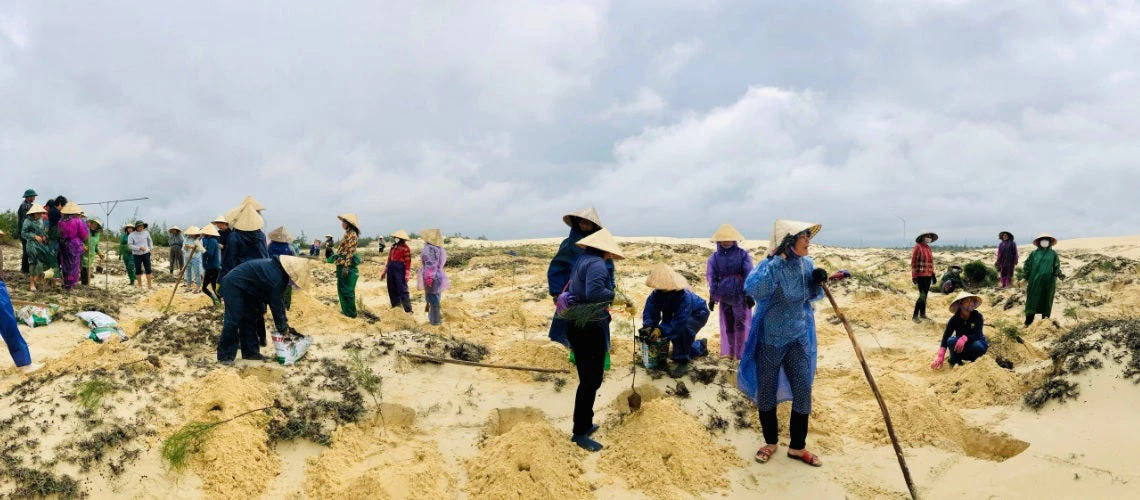 Women at work at a sandy soil coastal forest planting site in Vietnam.
Women at work at a sandy soil coastal forest planting site in Vietnam.
Vietnam, with its vast coastline extending over 3,000 kilometres, is not only home to prosperous fisheries and socio-economic activities but also bears the brunt of rising sea levels, flooding, and storms. Women and vulnerable groups are especially susceptible to the negative impacts of disasters and face a continuing income gap. To address both challenges, the World Bank is working with the Vietnamese government to implement a project to enhance coastal resilience through nature-based solutions (NBS). As a result, the country is becoming more resilient through activities like mangrove planting and ecotourism, while women are prioritized for these and other income generating activities.
NBS aim to protect, restore, and manage natural ecosystems, often in combination with gray infrastructure, with the objective of strengthening climate resilience while providing environmental and socioeconomic benefits. However, if not designed correctly, women, persons with disabilities, low-income households, and other marginalized groups may face barriers to accessing these benefits. Local and indigenous community participation is crucial for successful NBS implementation, especially in contexts of fragility, conflict, and violence. An inclusive disaster risk management approach calls for integrating gender and social inclusion considerations in NBS interventions from the onset. Moreover, these interventions must be customized to local contexts to ensure maximum benefits for all social groups.
The World Bank, with support from the Global Facility for Disaster Reduction and Recovery (GFDRR) has launched a new guidance note that provides entry points for gender and social inclusion in NBS in urban, coastal, and forest and farmland settings. The guidance note includes a range of examples that illustrate opportunities for inclusive design.
For instance, in urban public spaces, inclusive design features such as lighting and accessibility for persons with disabilities can be critical to ensure NBS benefits reach all groups . Adding features such as seats, accessible toilets, and drinking fountains in the NBS design, financing, and maintenance plans can help overcome social exclusion. Similarly, coastal NBS can be made more inclusive through accessibility measures such as slip-resistant paths and access ramps. NBS in forest and farmland settings can adopt inclusive approaches to integrate marginalized groups into sustainable resource management and livelihood activities.
When it comes to NBS, one size does not fit all. It's crucial to tailor these solutions to the specific needs and challenges of the communities they serve. This also applies to the socioeconomic impacts of NBS, which can be incredibly beneficial for marginalized groups if implemented correctly. But to achieve these benefits, relevant stakeholders must be given a seat at the table from the beginning.
To construct a truly effective and inclusive NBS that benefits everyone, the following strategies can be employed:
- Incorporating gender and socially inclusive considerations from the early stages of project planning. For example, the Transforming Landscapes for Resilience and Development Project in Zambia has successfully integrated gender considerations by increasing women's participation in the planning and implementation processes for various adaptation-related livelihood support activities.
- Adapting NBS interventions to local contexts, including tailoring the approach to the specific location, resources, objectives, and fragility situation of a country. For example, the Sao Tome e Principe Transport Sector Development and Coastal Protection Project is addressing local communities’ needs by training groups to use innovative techniques, including NBS, for climate-resilient roads and coastal protection, while promoting women’s employment in the road sector.
- Conducting stakeholder consultations to identify locally relevant solutions, ensuring that all vulnerable groups' needs are accommodated, and preventing or reducing any negative impacts of NBS’s interventions. For example, in the Forest Sector Modernization and Coastal Resilience Enhancement Project in Vietnam, women were involved from the early consultation stages to design interventions that would benefit them directly.
To maximize their benefits, it is crucial that NBS programs adopt an inclusive approach that engages and empowers communities, especially those who have traditionally been excluded or marginalized. This approach involves recognizing and respecting local knowledge and practices, promoting equity, and ensuring that the benefits of nature-based solutions are distributed fairly. By doing so, we can not only achieve climate change adaptation and carbon sequestration targets but also create jobs, improve food security, and enhance the well-being of local communities. Inclusive nature-based solutions are not only the right thing to do but more importantly, the smart thing to do!
The new guidance note “Integrating Gender and Social Inclusion in Nature-Based Solutions” was developed by the Nature-Based Solutions for Climate Resilience (GPNBS) and the Inclusive Disaster Risk Management and Gender Equality Thematic Areas of the Global Facility for Disaster Reduction and Recovery (GFDRR).





Join the Conversation